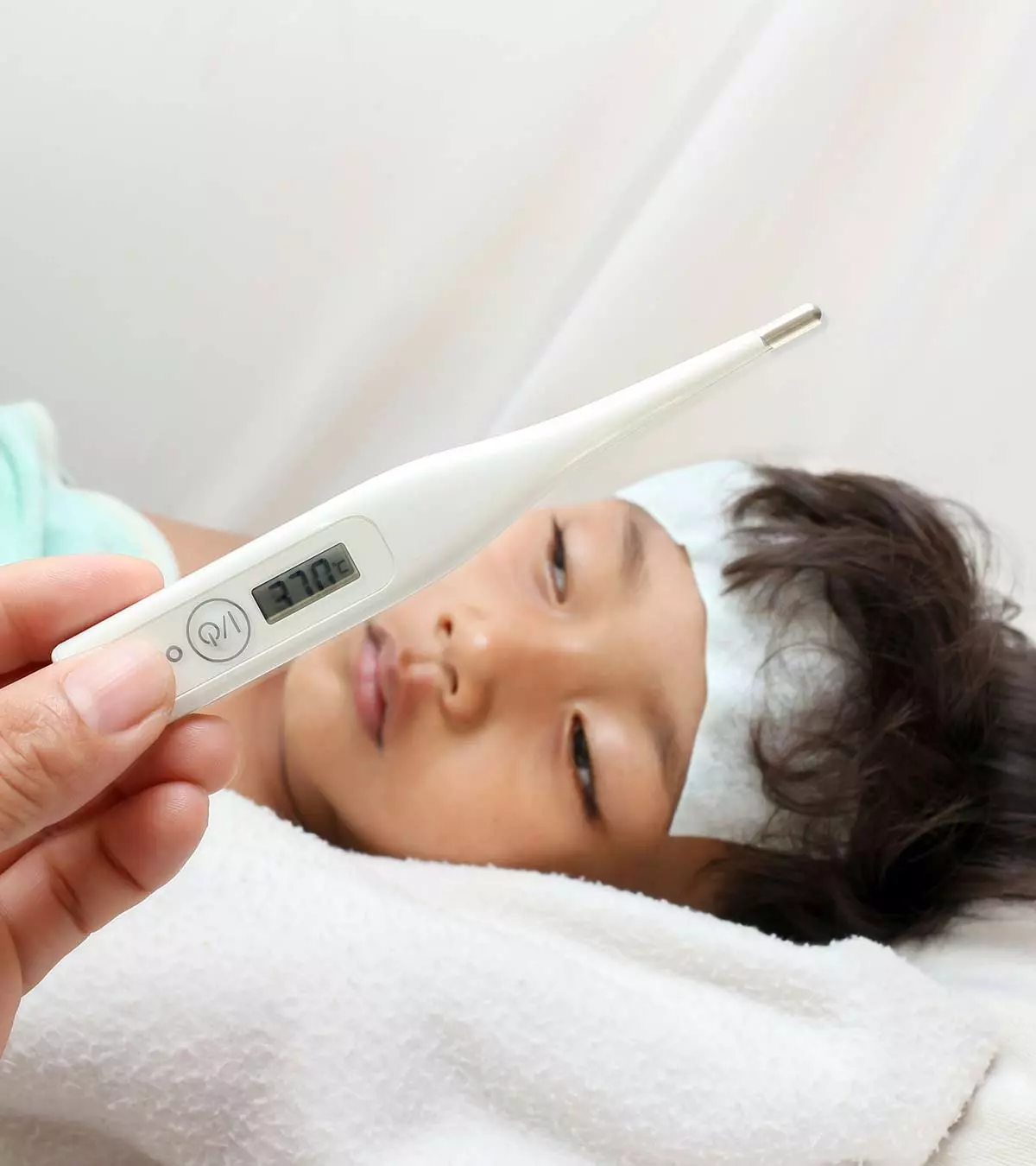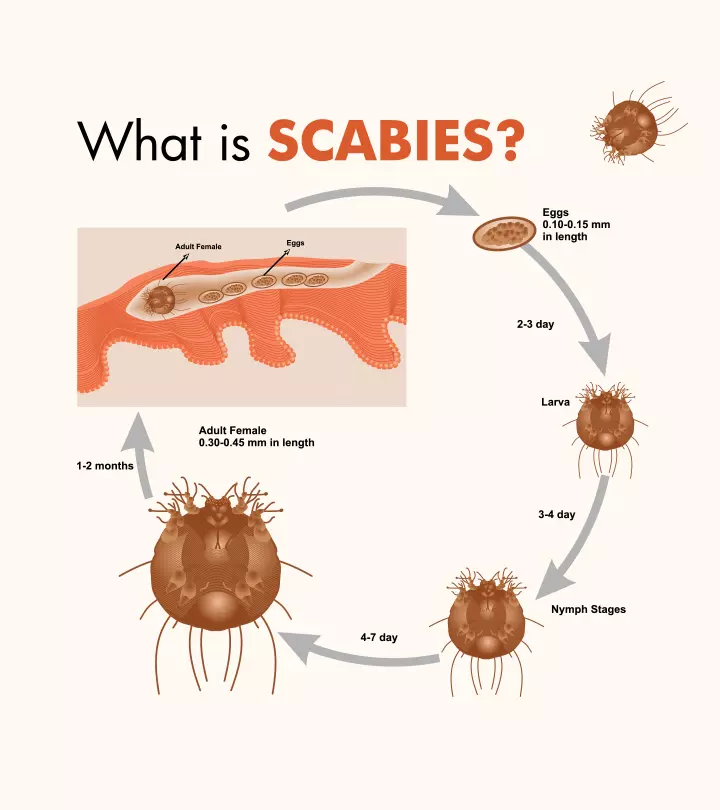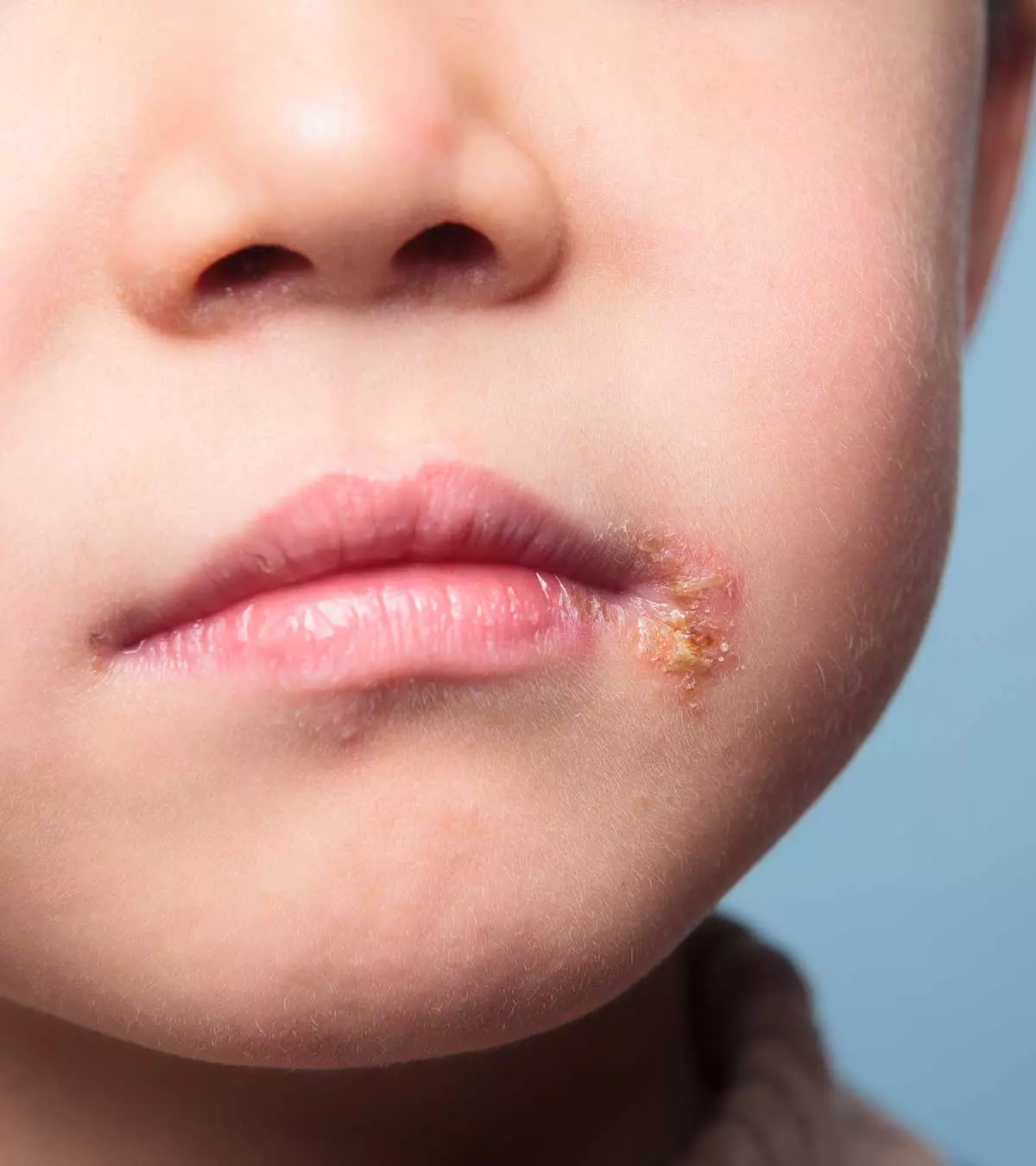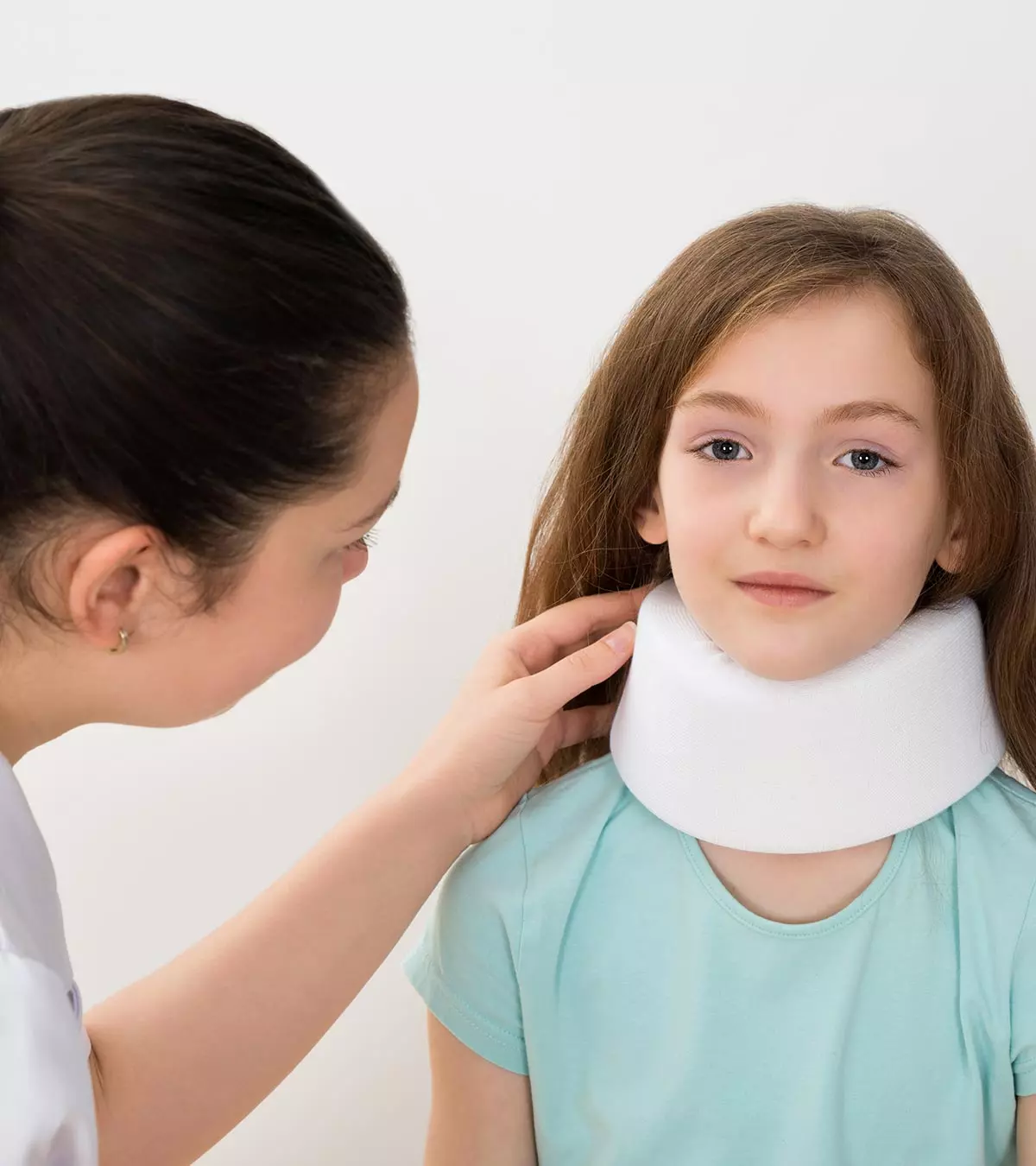
The word, torticollis, is derived from the words tortus, meaning twisted, and collis, meaning collar. It refers to a pediatric condition in which the neck is slightly twisted or bent to a side, while the chin has a tilt on the opposite side (1). Torticollis in children may be congenital or acquired later in life.
It is a painful condition in which the child usually experiences neck stiffness and is unable to move it freely, thus interfering with their daily activities. Physioherapy may be an effective option for relieving the stiffness and pain in the neck, but medical treatment or surgery may be required in some cases.
Read this post to know more about Torticollis or wry neck in children, its causes, symptoms, and treatment options.
Key Pointers
- Torticollis is a severe and painful condition in which children are unable to move their necks beyond a certain range and have a tilted neck.
- The condition may develop due to an injury, muscle strain, or restricted position in the womb (before birth).
- Physiotherapy, including physical activity, muscle movement, and stretching exercises, are natural ways to treat the condition in children.
- Specific corrective measures, massage, and warm compresses may also help alleviate symptoms of torticollis.
- Consistent and appropriate medication and therapeutic interventions can help cure the condition in the long term.
Causes Of Torticollis In Children
Torticollis in children can be acquired, meaning it develops at a certain point due to external
factors or illnesses
. Sometimes, it can be congenital, which is present during the time of birth. Here are some of the causes of acquired and congenital torticollis.
1. Congenital torticollis

Image: IStock
In congenital torticollis, a common musculoskeletal disorder in in babies, the sternocleidomastoid (SCM) muscleiThe superficial muscles of the neck that facilitate movement of the head and flexing of the neck. is shorter and tighter. The occurrence rate of congenital torticollis ranges from 0.3% to 1.9% globally, according to data from the National Institutes of Health. The occurrence rate of congenital torticollis ranges from 0.3% to 1.9% globally, according to data from the National Institutes of Health. Although the cause is unknown, here are a few possible reasons why that happens:
- The condition can develop in the womb due to limited space in the uterus, which makes the baby’s head to get stuck in one a certain position for some time, causing stiffness in the neck muscles (2).
Amber, a blogger and a mother, talks about her baby Jolie’s journey with torticollis. She says, “Torticollis is the result of various circumstances, but in Jolie’s case, it is due to her position in the womb… Jolie’s shortened neck muscles on her right side caused her to ’tilt’ and did not allow but about 30% range of motion… After starting therapy with Suzan, we learned so much about this treatable ‘condition’.
“Torticollis, as well as the baby developing a flat head, can be caused by the shape of the mother’s uterus and the position of the baby in utero, which explains why Miss Jolie developed tort and Parker (Jolie’s twin) did not. Jolie is Baby A, which means she was lower and very squished. I carried Parker right smack in the middle while Jolie was very low and smooshed to the side of my uterus (i).”
- Abnormal development of the SCM muscle or its absence (3).
- There is no substantial proof that the condition is hereditary, but some in the medical fraternity consider that as a possibility (4).
- In rare cases, congenital torticollis is a result of the Klippel-Feil Syndrome, a congenital disability that results in the fusion of neck vertebrae (short neck)(5). This syndrome has other symptoms, of which torticollis is one; so, take your doctor’s opinion for a more accurate diagnosis.
- Congenital bone abnormalities such as fusion or segmentation anomalies in atlas and axis bones (part of the bones in the neck).
- Certain syndromes such as Down syndrome, Morquio syndromeiA rare birth disorder affecting the body’s ability to break down long chains of specific sugar molecules. , Larsen syndromeiA genetic condition that impacts the normal development of bones in the body. , Marfan syndromeiA genetic disorder adversely impacting the connective tissue in the body and affecting organs such as the heart, eyes, skin, and lungs. , and cervical spine arthritis can also cause wry neck (6).
2. Acquired torticollis
Torticollis caused due to an external factor is called acquired torticollis. Given that the condition can be ‘acquired,’ several factors can result in a wry neck in children:
- Trauma to the head or neck or both. This could also include fracture and dislocation, muscle spasms, or damage to the neck muscles, especially the SCM muscle or the trapezius muscle.
- Infections in the neck, head, spine, or CNS can cause torticollis. The condition could also develop due to infections in the ear or posterior pharynx.
- Surgical removal of adenoidsiA patch of tissue in the throat that helps in trapping the germs that enter the nose and the mouth. , respiratory infections, or infections in the neck’s soft tissues (7).
- Gastroesophageal reflux (GERD), inflammation in the neck region, spasmus nutansiA disorder characterized by rapid, uncontrolled eye movements and bobbing of the head. , and Sandifer syndrome (8).
- Children who have eye impairment and cannot move their eyes tend to move the head, leading to prolonged periods of head tilt, causing neck muscle stiffness (6).
- A tumor in the brain, especially in the skull or spinal cord, can be a cause. Sometimes, tumors in the posterior fossa can result in torticollis accompanied by nausea, headaches, vomiting, and other neurological symptoms. (1) The spinal alignment can be checked in such a case.
While you can detect the presence of torticollis or wry neck by looking at the child, you will not be able to identify the exact cause of the condition. Hence, you must check with your child’s doctor to diagnose the type of torticollis, some of which can be resolved with simple exercises, whereas some need medical intervention.
Let us look at each type next.
 Quick fact
Quick factTypes Of Torticollis In Children
Torticollis occurs when the trauma or strain on the neck is severe. It can also occur due to the causes listed above, based on which the condition is divided into the following types (9).
1. Temporary torticollis

Image: IStock
This condition is temporary and would go away after a couple of days. This could be due to:
- Improper sleeping patterns and infant positioning can strain the neck, resulting in pain in the neck. If the strain is too much, it can lead to stiffness of the neck and temporary torticollis.
- Sometimes, your child can develop torticollis due to an infection in the ear or throat or a cold, which causes swelling of the lymph nodes.
2. Fixed torticollis
Sometimes, torticollis in children can be a permanent condition, because it is either congenital or acquired when the neck is irreversibly damaged due to trauma. Fixed torticollis, also known as acute torticollis, is usually caused due to a flaw in the bone structure or the muscles. It can also be a result of a tumor in the brain or the spinal cord. Babies with fixed torticollis may have a flattened or slightly tilted head.
3. Muscular torticollis
Sometimes, tight muscles on one side of your child’s neck can cause a type of fixed torticollis called muscular torticollis. The muscle tightness prevents easy movement of the neck and even tilts the head to a side.
4. Cervical dystonia
Also known as spasmodic torticollis, cervical dystonia is a rare condition that is recurrent. Children with cervical dystonia have difficulty moving their heads to the sides and sometimes even forward or backward due to pain. However, this condition is typically found in adults between the ages of 40 and 60 (10).
 Things to know
Things to knowThe severity of the condition, the treatment, and the symptoms may depend on the type of torticollis in the child. But how do you know what kind of torticollis your child has? Well, watch out for the symptoms.
Torticollis Symptoms In Children
Unlike other diseases or medical conditions that aren’t obvious, torticollis has outward symptoms that are hard to miss. Here are the symptoms you should look for to diagnose torticollis in a child.
- The child’s head is visibly tilted to one side.
- There is stiffness in the neck, accompanied by pain when your child tries to move his neck.
- A headache is also a symptom, although not all children complain of it.
- Swelling in the neck muscles.
- Your child cannot move the neck beyond a certain range and in all directions.
- In babies, the head may seem flattened and unbalanced.
- In some types of acquired torticollis that are recurrent, the episodes may be accompanied by dizziness, nausea or vomiting and irritability(1)
- In the case of congenital torticollis, you may notice a pea-sized tumor-like lump on the sternocleidomastoid (SCM) muscle in the neck. The lump usually goes away as the baby grows, or it might need surgery (11).
- In some cases of early or infantile torticollis, there may be a slight delay in motor (muscular) development, affecting fine motor skills. However, some studies contradict this, so further investigation is needed to establish the effects on child development (12) (13).
Some of the symptoms of torticollis are subtle, which is why a medical diagnosis is necessary to find the underlying cause. Early recognition of these symptoms is crucial for timely intervention. Parents should monitor for any signs of discomfort or abnormal head positioning, as early diagnosis can lead to more effective treatment options and better outcomes for the child.
Diagnosis Of Torticollis

Image: IStock
When we talk about diagnosing torticollis, we are talking about the underlying illness that has resulted in the condition. To pinpoint the reason and to treat it, your child has to undergo certain tests and procedures (9).
- A physical examination of the neck is done to check for tenderness or swelling. If there are no external signs, an investigation through diagnostic procedures is recommended.
- The doctor will also check for congenital muscular anomalies by examining the shape of the head and the hip.
- Neurological, visual, and ENT examinations are recommended to check for infections.
- The physician will suggest a cervical spine X-ray in case there is tenderness or pain in the region.
- If they suspect an anomaly in the CNS or brain, then a CT scan would be recommended.
- An EMG is done to detect the damaged muscles in the neck.
Torticollis (Wry Neck) Treatment In Children
Torticollis cannot be prevented, but there are certain treatment options available to reduce inflammation and pain. In the case of congenital torticollis, early interventions might help improve the condition. For acquired torticollis, the treatment is provided based on the cause.
Below are the various treatment options available for different kinds of wry neck.
1. Congenital torticollis
If your baby has a wry neck by birth, then it could be improved with the below treatments.
Physiotherapy: Congenital torticollis could be improved by stretching the neck muscles through physiotherapy. This must be started soon after the birth, preferably within a few months, for improved chances of success (14). To ensure rehabilitation, your pediatrician may also recommend sensory integration therapy.

Image: Shutterstock
TOT collar: Your doctor might prescribe using a device known as TOT collar, which stands for Tubular Orthosis for Torticollis. This is a small plastic tubing which can be placed around the baby’s neck to help straighten the neck and strengthen the neck muscles.
Note: The TOT collar should be used only when the child is awake and under supervision. It should not be used for children under the age of four months (15).
Corrective measures: Babies with an asymmetrical head might respond well to corrective measures, such as:
- Corrective helmets and molding cups
- Changing the Sleeping positions
- Special exercises (14)
Surgery: When the above non-surgical methods fail to provide relief, then the doctor might go for surgery to correct the shortened SCM muscle. Based on the condition of your child after the surgery, the doctor might prescribe neck braces to prevent relapse and maintain normal neck movements (16).
Your child’s doctor is the best person to determine the course of treatment. However, as a parent, you should be able to identify the subtle early symptoms and take your baby to the doctor as soon as possible.
2. Acquired torticollis
If the problem is not congenital but acquired, there are various ways to treat it, depending on the cause:
- Traction
- Stretching exercises
- Heat application
- Massaging
- Physiotherapy
- Neck braces
- Your doctor might prescribe certain medications such as nonsteroidal anti-inflammatory drugs to relieve pain and inflammation if the torticollis is due to spine or musculoskeletal injury.
- Antibiotics might also be given if the wry neck is due to infection.
- Medications to treat GERD could be prescribed if that is causing the condition (14).
Home Care And Remedies For Torticollis
Torticollis cannot be treated at home, but you can certainly make the condition bearable for your child. Here are a few things you can do at home to ease the pain and discomfort that torticollis causes to your child.
- Temporary torticollis goes away after a day or two of rest. So, let your child rest as much as possible. But if it persists, go to a doctor for a proper diagnosis, as delayed treatment can make the problem worse.

Image: IStock
- If your child complains of neck pain in the morning, check the place where they have slept. A lumpy, uneven pillow can aggravate neck pain.
- Give your child pain medicines, such as ibuprofen, in case of acquired torticollis, which can heal any muscular discomfort. Consult a doctor before you do, though.
- Warm compresses can alleviate the pain caused by a stiff neck. They loosen the neck muscles and make it easier to move the head.
- A muscle relaxant might help, use it only if your doctor prescribes them.
- Help your child use a neck brace to keep the head still to prevent further strain.
Long-Term Care For Torticollis In Children
Health problems like torticollis can make life challenging for a child. As a parent, you can help your child manage the condition better until it is corrected through treatment. Here is how.
- The time duration needed to cure the problem is primarily based on the cause of torticollis. So, try to ease the pain and discomfort with the help of exercises and massages.
- Physiotherapy may be recommended for a year or more.
- Take your child on regular visits to the doctor to ensure his progress.
- Try and help your child build a positive attitude towards the problem and help them cope actively.
Questions To Ask Your Doctor
Torticollis treatment for children can be effective when you take proper care of the child at home. And to do that, you need to be aware of the condition, its severity, and what you can do to make it better for your child. Remember to ask your doctor about:
- The type of torticollis that your child has.
- Home remedies to help your child move his or her neck easily, without aggravating the pain.
- Any changes that need to be made to the child’s bed to prevent further strain to the neck.
- Any side effects of the medication prescribed.
- Physiotherapy exercises that you can do at home to relieve pain.
- The frequency of doctor visits and terms of medication or treatments.
Frequently Asked Questions
1. Is congenital torticollis common in children?
A retrospective cohort study found that congenital torticollis is the most common type of torticollis in infants (17).
2. Which doctor should I consult if my child has torticollis?
Ask your child’s pediatrician first. They may recommend a surgeon or physiotherapist depending on the severity of the condition.
3. Can torticollis be prevented?
No. It is not possible to prevent torticollis. You can, however, try and avoid getting a stiff neck.
4. How long does the treatment last?
The duration of the treatment depends on the severity of the condition.
5. I noticed that my child tilts her head only to the left side. Should I be worried?
If your child’s head is tilted constantly to one side, look for other symptoms such as neck pain or lumps, and then consult your child’s doctor.
6. Who is at a higher risk of getting congenital torticollis?
The causes of congenital torticollis are not known. However, studies found that factors such as the baby being the first-born child, multiple gestations, dystocic delivery (where the baby’s head is out, but the body is caught above the pubic bone) could contribute to the occurrence of this condition(17).
7. What exercises should I make my child do to fix torticollis?
Please consult a physiotherapist who can recommend the right kind of neck exercises for treating torticollis in your child.
8. At what age can torticollis be diagnosed?
Congenital torticollis can be diagnosed in babies when they are a few weeks old. As they start gaining control of their head, you may notice that they are unable to turn their head. Acquired torticollis, on the other hand, can be diagnosed in the first four to six months or even later (18).
9. Is torticollis a disability?
In most cases, torticollis is treatable and the child’s condition improves over time (19). However, in some cases such as spasmodic torticollis or Klippel-Feil syndrome, the child may experience pain or immobility over a long period. Besides, they may experience difficulty performing daily activities. In such cases, torticollis may be considered a disability.
10. Is torticollis a symptom of cerebral palsy?
Yes, torticollis can be a symptom of cerebral palsy. Torticollis causes the neck muscles to become tight and the head to tilt to one side, leading to a limited range of motion in the head and neck. This restricted motion is one of the many symptoms individuals with cerebral palsy often exhibit.
11. Does torticollis hamper brain development?
Torticollis is a muscular condition that does not hamper brain development by itself (18). However, if left untreated, it can lead to several issues that may hinder proper infant development.
12. Does torticollis affect speech?
Torticollis can cause plagiocephaly (flat head syndrome), affecting the positioning of the jaw, soft palate, and tongue, which may cause a child to develop speech issues (20). However, prompt intervention can help prevent or minimize the development of plagiocephaly.
13. Is torticollis permanent?
In most cases, torticollis is treatable, and the child will improve with early intervention (18). However, it may be permanent in cases where torticollis is caused by certain neurological conditions, such as cerebral palsy.
Torticollis in children can be congenital or acquired, and there are many different types, including temporary, fixed, muscular, and cervical torticollis. While most types of torticollis are inevitable, there are a few that you may try to avoid ahead of time. For instance, congenital torticollis can also be treated through early intervention. So, look out for any symptoms or indicators of a twisted neck in your child and start with physical therapy and occupational therapy. If that fails, surgery is always an option.
Infographic: What Is The Treatment For Acquired Torticollis In Children?
Torticollis in children can either be congenital, i.e., present at birth, or can be acquired due to several conditions, such as an infection, trauma, GERD, and other conditions, requiring specific treatment depending on the underlying cause. Check out the infographic below to learn about available treatment options for acquired torticollis in children.
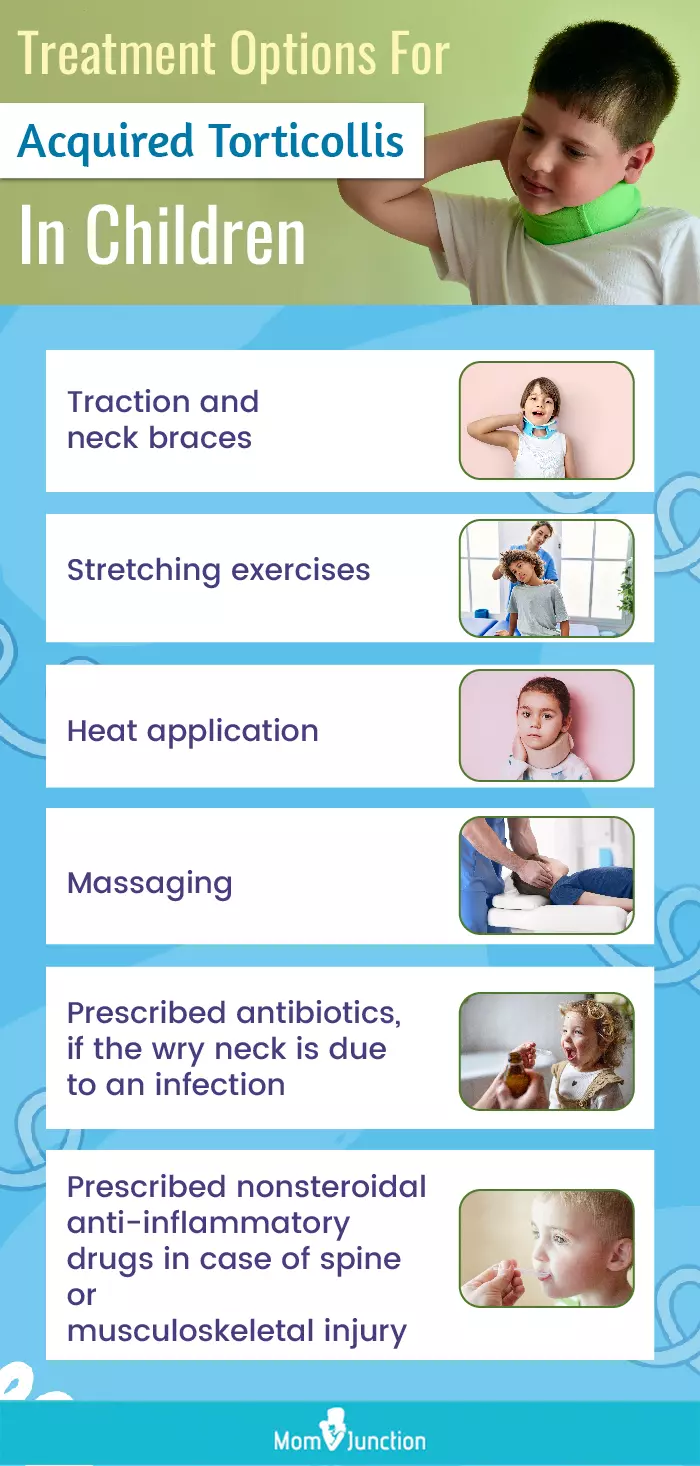
Illustration: Momjunction Design Team
Illustration: What Causes Torticollis In Children And How To Treat It

Image: Stable Diffusion/MomJunction Design Team
Personal Experience: Source
MomJunction articles include first-hand experiences to provide you with better insights through real-life narratives. Here are the sources of personal accounts referenced in this article.
i. Jolie’s journey | torticollis;https://themasseyspot.blogspot.com/2013/08/then-to-now-jolies-torticollis.html
References
1. Herman MJ; Torticollis in infants and children: common and unusual causes; NCBI(2006)
2. What is Torticollis?; Health in Wales
3. Saira Haque, Badar Bin Bilal Shafi, Musa Kaleem; Imaging of Torticollis in Children; RadioGraphics
4. Engin C, Yavuz SS, Sahin FI; Congenital muscular torticollis: is heredity a possible factor in a family with five torticollis patients in three generations?; NCBI(1997)
5. Ashok Kumar Agarwal, et al.; Klippel Feil Syndrome: A Rare Case Report; NCBI(2014)
6. Torticollis (Pediatric); Columbia Doctors
7. Torticollis (congenital and acquired) in children; NHS Greater Glasgow and Clyde Guidelines8. Bercik D, Diemer S, Westrick S, Worley S, and Suder R; Relationship Between Torticollis and Gastroesophageal Reflux Disorder in Infants; NCBI(2019)
9. Torticollis; Seattle Children’s Hospital
10. Cervical Dystonia; National Organization for Rare Disorders
11. Neck Masses; Children’s Hospital of Philadelphia
12. Ohman A1, Nilsson S, Lagerkvist AL, and Beckung E; Are infants with torticollis at risk of a delay in early motor milestones compared with a control group of healthy infants?; NCBI(2009)
13. Öhman A, Beckung E; Children who had congenital torticollis as infants are not at higher risk for a delay in motor development at preschool age; NCBI(2013)
14. Torticollis | Treatments; Boston Children’s Hospital
15. Craniofacial Society: An Overview of Torticollis; The Academy Today
16. Kumar Nilesh and Srijon Mukherji; Congenital muscular torticollis; NCBI(2013)
17. Amaral, Daniela M, et al.; Congenital muscular torticollis where are we today? A retrospective analysis at a tertiary hospital; Porto Biomedical Journal
18. Torticollis; Cleveland Clinic
19. J van den Dool, M A J Tijssen, J H T M Koelman, R H H Engelbert, and B Visser; Determinants of disability in cervical dystonia; National Library of Medicine
20. Brent Collett, David Breiger, Darcy King, Michael Cunningham, and Matthew Speltz; Neurodevelopmental Implications of “Deformational” Plagiocephaly; National Library of Medicine
Community Experiences
Join the conversation and become a part of our nurturing community! Share your stories, experiences, and insights to connect with fellow parents.
Read full bio of Dr. Nandita Chatterjee
Read full bio of Dr Bisny T. Joseph
Read full bio of Swati Patwal
Read full bio of Anindita Ghatak






